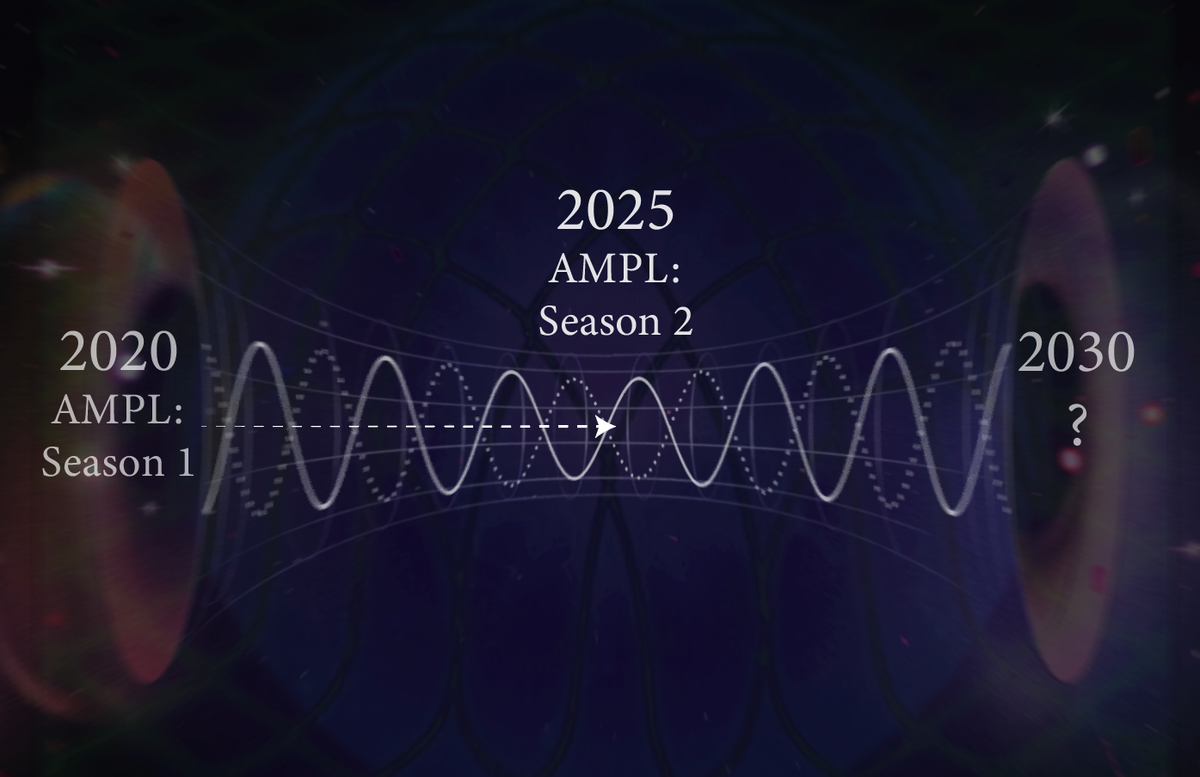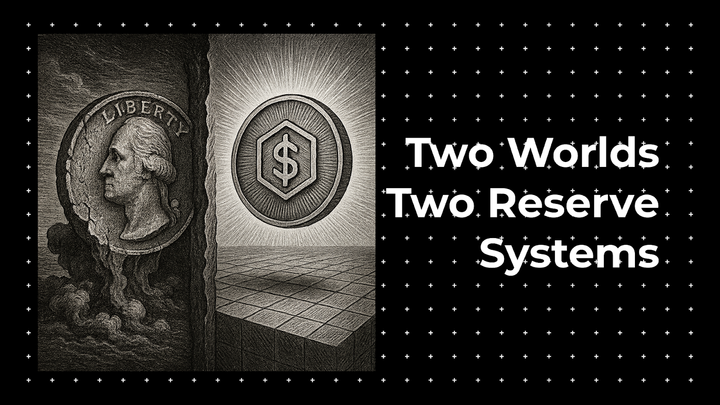AMPL: Season 2 | Catalyzing DeFi again, with SPOT Protocol
DeFi's next Liquidity BOOM is loading with SPOT Protocol. DeFi Summer 2020 was preceded by AMPL’s first BOOM. Will this time be different?

Lets be honest: you may be “here for the tech,” but at the end of the day there is only one thing that keeps this Game going - “numbah go up” $$$$
This is Pattern Recognition. Not Financial Advice.
Historical Context
What makes “numbah go up”?
Everything comes down to Liquidity. In Traditional Finance, Banks are the source. The more base money in circulation —> higher the asset prices are likely to soar.
Two ways this happens:
- Monetary Debasement (“Quantitative Easing”); aka Money Printer go BRRRRRR
- Think of this like the melting of glaciers & ice caps that floods the entire system with more water.
- Interest Rate Cuts
- Think of this like the opening of dam gates that allows more water to flow down rivers into (financial) banks.
For our purposes, this is a gross simplification of a nuanced phenomenon.
2017 | ETH ICO Mania
First came Bitcoin, and then followed Ethereum. In 2017, liquidity flooded through Ethereum. Why?
As global liquidity rose in 2017, Initial Coin Offerings (ICOs) enabled projects to raise money for all kinds of ideas and promises. These token sales were groundbreaking because the process was relatively frictionless as intermediaries were nearly absent; e.g., Brave browser raised $35M within 30 seconds of their ICO.
Most projects were built using the ERC-20 standard for fungible tokens on the Ethereum blockchain.
Investors purchased ETH → ETH was sent to a Smart Contract address → ICO tokens were received at the wallet address from whence the ETH was sent.
ETH price surged as this token was needed to participate in ICO sales. Naturally, as is the case with market psychology, this escalated into a bull mania and was followed by an inevitable crash when the bubble burst in 2018.
Lessons learned?
Ethereum Smart Contracts were validated as a powerful method for facilitating conditional and programmatic peer-to-peer value exchange 🤝. However, the Ethereum network lacked mechanisms (or “moat”) for retaining value. Most tokens, including ETH, were bought and sold on Centralized Exchanges (CEXes) which drew value away from the network. Over the ensuing bear market, insights were integrated and the application of these insights changed finance forever.
A New Dawn
2020 | DeFi Summer - AMPL Mega-Expansion: Season 1
In the Summer of 2020, Decentralized Finance (DeFi) came to life. Several developments facilitated what became known as “DeFi Summer,” including but not limited to:
- Liquidity Pools on Decentralized Exchanges (DEXes)
- In contrast to Order-Book trading on Centralized Exchanges, Digital Assets became tradable on the Ethereum Network itself through Liquidity Pools —> Trading Fees were distributed directly to Liquidity Providing End Users on Ethereum
- Incentivized Organic Onchain activity
- Liquidity Mining/Airdrops
- Along with Trading Fees, Liquidity Providing End Users were often rewarded in real time with additional Digital Assets —> this became known as Liquidity Mining (for tokens)
- Alternatively, some projects retroactively rewarded End Users with token “Airdrops” based on wallet interactions with their smart contracts —> most famously, the “UNIversal basic income” airdrop of 400 $UNI tokens per wallet (~$1200 at the time of distribution)
- Incentivized Speculative Onchain activity
- Stablecoins
- ERC-20 tokens pegged to $1 U.S. Dollar were available on the Ethereum Network; centralized (USDT, USDC, etc.) & ostensibly decentralized (DAI; now USDS)
- End Users could move between stable & risky Digital Assets entirely Onchain without intermediaries, promoting retention of value & liquidity on the Ethereum Network
DeFi Summer 2020 was essentially 2017 ICO Mania, but entirely Onchain the Ethereum Network. Whereas the 2017 ICO Mania unfolded in a backdrop of steadily rising global liquidity, DeFi Summer 2020 was precipitated by the fastest expansion of the U.S. Dollar in modern history.
However, this massive bolus stimulated the traditional finance economy - so, how, if at all, was this mechanism mirrored in Decentralized Finance?
There was one other breakthrough that catalyzed it all.
AMPL - Elastic Money; A New Primitive
When the Ampleforth Geysers went live in July 2020, Liquidity Providers of the ETH-AMPL pair who staked their LP token in the geysers were rewarded with $AMPL tokens through the Geyser Liquidity Mining campaign.
$AMPL was the first Supply Elastic digital asset.
Instead of the conventional Price changes observed with digital assets, End Users saw the Number of AMPL tokens increase (Positive Rebase) or decrease (Negative Rebase) in their wallets every 24 hours. Furthermore, the Geysers' reward emissions were parametrized by a time-based multiplier.
The result of this novelty?
Demand for AMPL skyrocketed. The token’s total circulating supply expanded from ~20M to ~800M (Market Cap: ~$21M —> $1.6B) within a single month. However, AMPL was sold just as swiftly as it was acquired. Consequently, this value was absorbed by ETH and other ERC-20 tokens.
Like an explosive Fire, AMPL’s rapid expansion catalyzed DeFi’s growth as the Total Value Locked ballooned over the next few quarters:
2025 | Stablecoin Summer - AMPL Mega-Expansion: Season 2
5 years later the playing field has changed, and we’re ready for Season 2.
If Season 1 asked the question:
“Which liquidity pools could be filled with all of this liquidity that was created from AMPL, in order to financialize tradable digital tokens?” (Spoiler - any and every liquidity pool was filled, though temporarily)
then Season 2 might ask:
“Which ecosystems will sustainably channel liquidity - similar to the flow of water through irrigation systems - to generate products that deliver organic yield or revenue for End Users?”
Ethereum is faster, cheaper, and easier to use with Layer 2 scaling solutions. And instead of isolated Liquidity Pools, pipelines have evolved to vitalize ecosystems across the globally distributed permissionless ledger.
Legislation is being actively drafted to establish regulatory CLARITY for a digital assets framework, so that GENIUSes can “cook” and design innovative mechanisms for yield-bearing digital dollars; aka Stablecoins.
In other words, this time around the “numbah go up” to monitor is the Yield - this is where the Signal lies, for value will accrue to those assets & ecosystems that win this Game.
Here, Ampleforth is once again ahead of the Game with SPOT Protocol.
What happened to the Fire that was AMPL?
Like Ethereum, AMPL too has a “moat” now. Similar to the well-timed placement of Fire within spark plugs of Internal Combustion Engines, the thermal energy of AMPL has been harnessed for Utility. A Rotation Vault has been designed to contain the “explosions,” so that value does not leak from the Ampleforth ecosystem this time. Instead, it is transferred to output and sustain SPOT.
What is SPOT?
If AMPL is thermal like Elemental Fire, then SPOT is quintessential like Elemental Ether because SPOT is simultaneously many things. It is the World’s 1st digital asset that is:
- Free-Floating
- Decentralized
- Liquidation-Immune
- Inflation-Resistant
SPOT Protocol closed the Internal Combustion Engine loop by automating rotations with the Rollover Vault. As depicted above, these operations unfold in the open on the free market. Resultantly, a dynamic equilibrium driven by market participants enables SPOT to float and exhibit buffered price volatility.
New Game
Not only is Ampleforth ahead of the Game, Ampleforth is also changing the Game with SPOT Protocol. While everyone else has been devising methods for optimizing yield by obfuscating design flaws (e.g., Off-chain accounting, trading fees, etc.), SPOT yield is transparent and entirely Onchain - and consequently, so is the yield for the digital dollars it will be used to collateralize.

In addition to all the digital asset "firsts" listed above, SPOT is the first digital asset of a brand new class: Low Volatility Assets (LVA).
SPOT is free-floating within a bounded range, exhibiting predictable price variability while oscillating around a mean-reverting Fair Market Value (spot_fmv; above). Simultaneously, SPOT delivers a higher than average yield (spot_funding_rate; above).
Altogether, these qualities place SPOT as - arguably - the most suitable collateral asset for decentralized Stablecoins.
It is said that in “crypto,” multiple timelines seem to be converging. So in addition to harnessing digital thermal energy (AMPL) for rotations, will we observe the utility of motion directed towards a digital monetary version of Electricity (GIF above)?
Current is measured in Amperes, and perhaps that’s why it is called AmpUSD:
Stablecoin Summer Loading
Though highly volatile, Bitcoin (BTC) has matured over the last decade and is widely regarded as a digital Store of Value. Since DeFi Summer 2020, Ethereum (ETH) has matured as a reliable Medium of Exchange by virtue of its irreplaceability within Liquidity Pools programmed by Smart Contracts.
With all eyes on Stablecoins and SPOT configured to power an inflation-outpacing digital dollar, is AMPL poised to mature and establish its foothold as DeFi's Unit of Account?
Time will tell.
One thing is for sure:

In DeFi Summer, Stablecoin Market Capitalization was less than the Total Value Locked (TVL). Since then, the metrics have flipped.
What does this mean for DeFi's TVL moving forward?
We saw what happened in AMPL: Season 1 - and now, AMPL: Season 2 is about to begin.
With interest rate cuts imminent, AMPL's next expansion is sure to "make numbah go up." And as we've explored above, this time we're not merely talking about Price.
Understanding AMPL right now is likely to yield the highest return on investment for your Attention. Learn-2-Earn.
Lock in.
References
- SPOT Protocol (official)
- SPOT Protocol Rotation Vault (official documentation)




